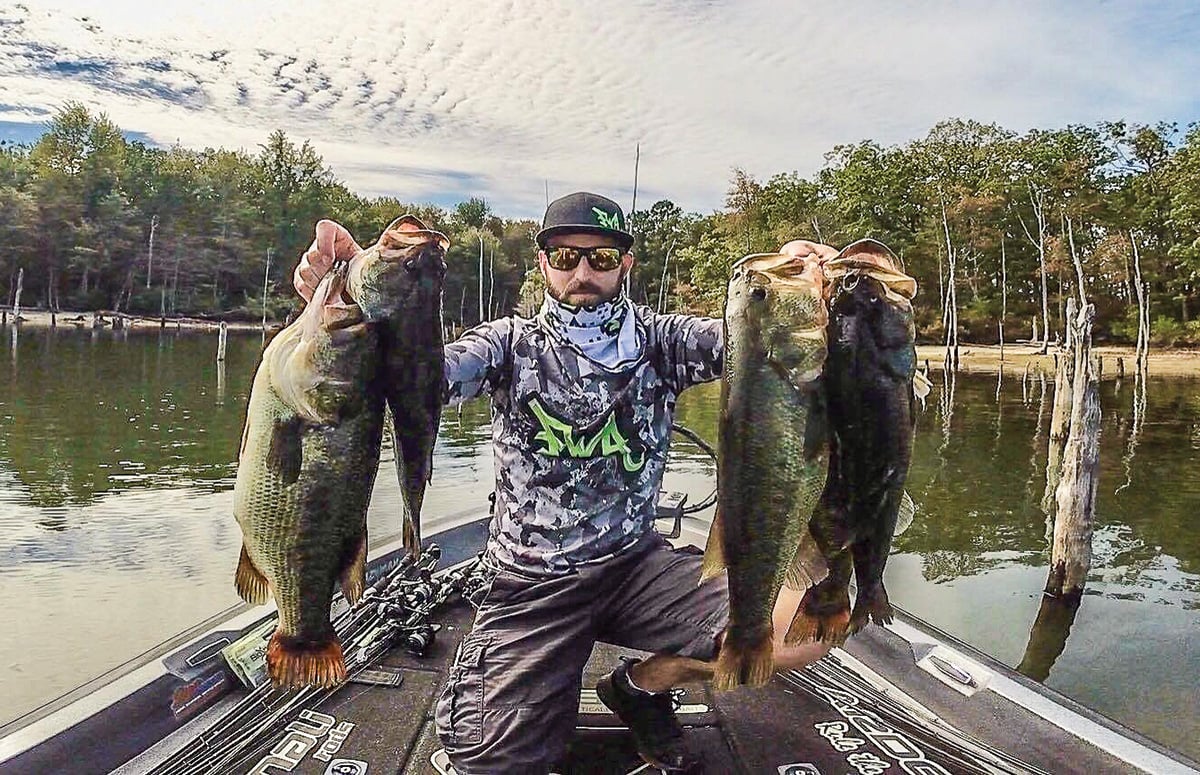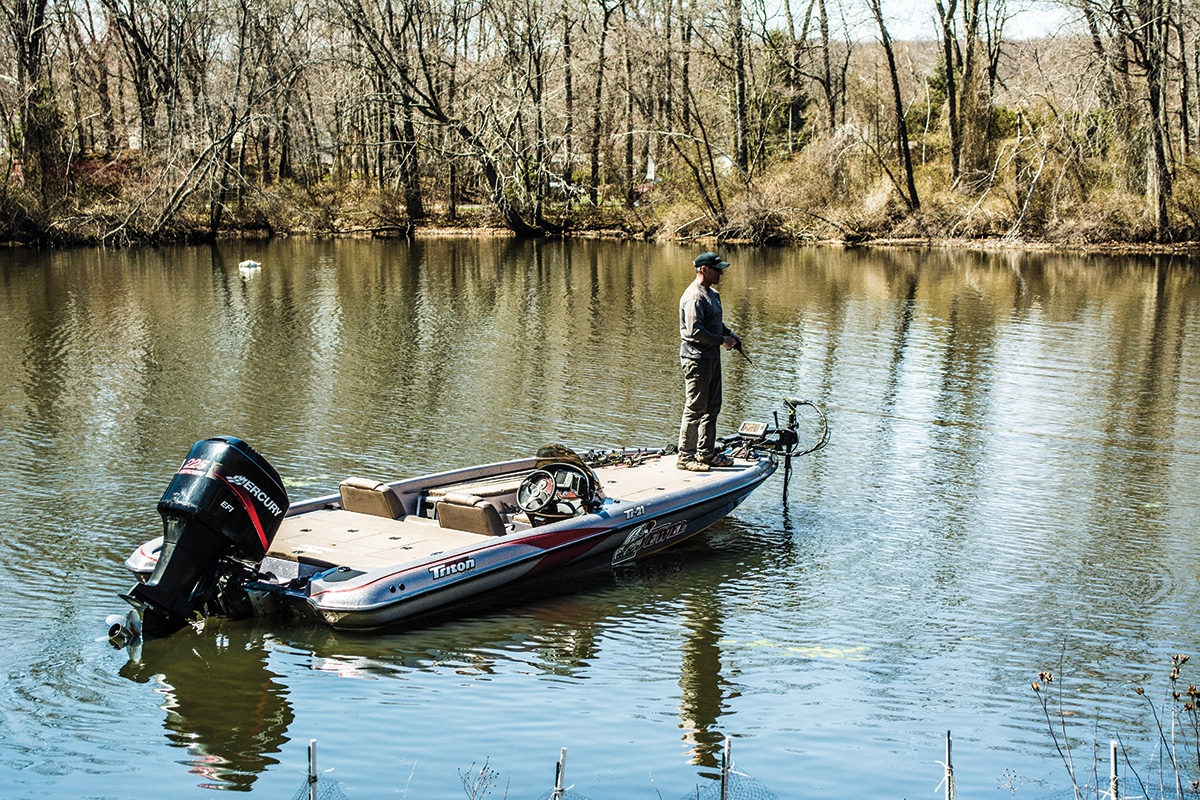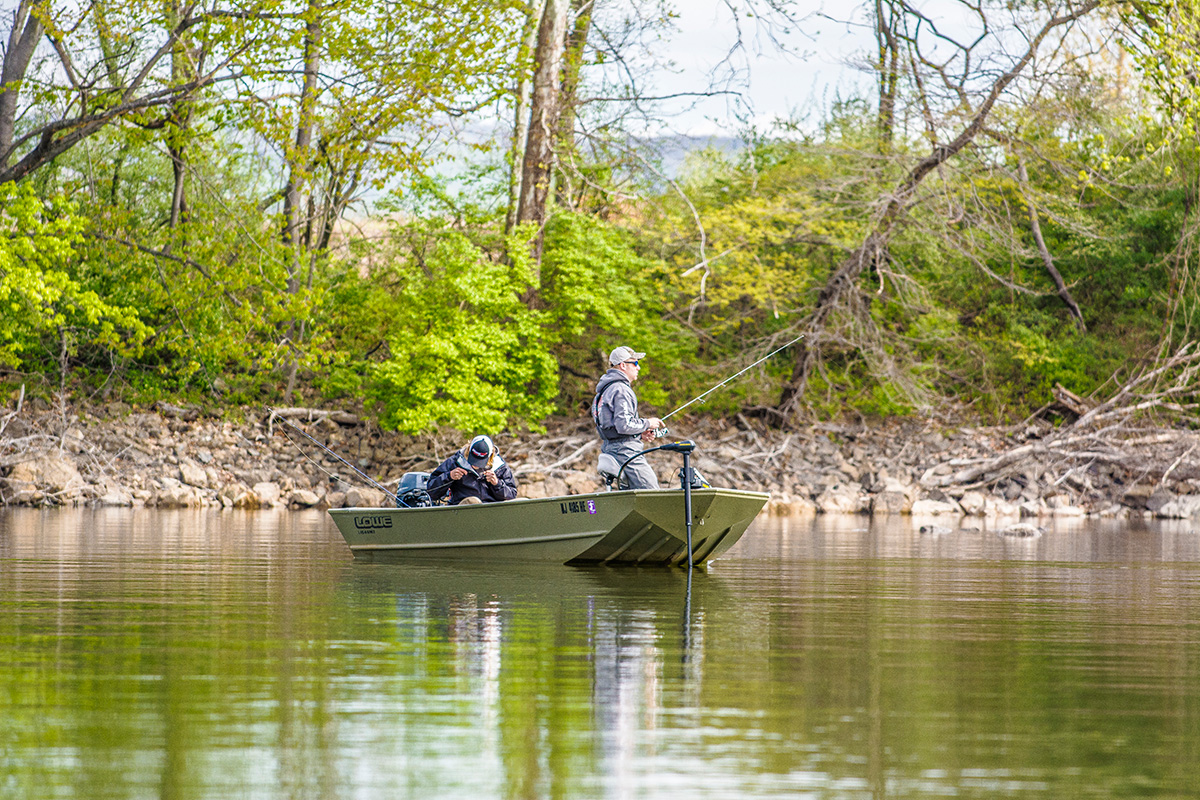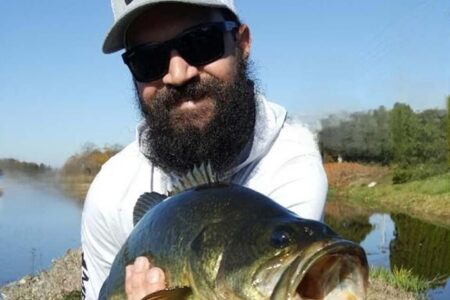
Steve Vullo, a popular name on the New Jersey bass fishing scene, operates the Fishing with Attitude Facebook site, but above all else, he catches big bass.
Really big! As yet, his best New Jersey largemouth, caught in Manasquan Reservoir during the early April 2017 pre-spawn, weighed 7.07 pounds. He routinely catches 4- and 5-pound largemouths, because focus and specialization marks his success. During an hour-long interview, Vullo told me he likes teaching others. I remarked in turn that without trading knowledge, we wouldn’t have a fishing scene.
All of us have secrets, but divulgence of information incentivizes us to learn more. Vullo’s approaches will help prepare you for great opportunities about to unfold this spring, and, like him, you may catch a bass worthy of a lifetime.
The Spring Cycle
Vullo reverses his fall fishing routes beginning in March. At ice-out, bass are deep, where they’ve spent the winter. A few warming days gets them started towards shallows. “It doesn’t take much to get fish into a pre-spawn,” he said. “I start where I left off in the fall.” That’s very late in the season, bass in winter depths. Now bass need warmth to nurture eggs, and they feed to boost metabolism.
“You have to be glued to your electronics. Why here, not there?” Vullo said usually it’s because rocks or gravel on the bottom absorb warmth and stimulate bass to move along a hard-bottomed route towards shallows.
Early spring comes and goes by fits and starts. Vullo responds to days when bass, instead of making themselves more available, head back towards winter holes. He says he fishes by 10-foot ratios. Perhaps starting at 35 feet, if nothing is there, he goes to 25. Sometimes he expects to find bass back deep, but gets a surprise instead. He told me he once caught a 5-pound Spruce Run largemouth 2 feet deep with water temps in the 40s. I asked Vullo if he has bass routes mapped in his head from the various lakes and reservoirs he fishes, and he told me GPS became a habit only because a unit came with his new boat. He finds patterns in graph readouts better than most economists judge their data, I would assume.
Vullo feels eager for warm spring weather, because once that water temperature reaches the low 50s, bass actively invade shallows very close to where they will spawn, feeding readily. Faster availability of bass near visual targets like laydowns, timber, and rock outcroppings seems to relax Vullo’s focused mind so enthusiasm can enjoy a holiday, just like a spring afternoon for anyone after weeks behind a screen. Although that biggest largemouth of his hit a Binsky badebait 27 feet down, surface water temp at 43, he said, “Once the water is in the 50s, I will throw a spinnerbait and nothing but a spinnerbait all day. They can’t resist a spinnerbait when the water’s really warming up.” Usually by early May, largemouths spawn, but Vullo insists they sometimes spawn much earlier. He once caught five bass shallow in late March or early April on Spruce Run Reservoir, weighing almost 17 pounds. Each had reddened fins and underbellies indicative of bedding.
Keep in mind that pre-spawn bass may not stage far from where they will spawn, but use your best judgement to find where in the deep-to-shallow cycle they fin during a given outing. Chances are good they will be feeding, boosting that metabolism to nurture eggs. And just before spawning, they can get ferocious. “Right before they spawn, they’re aggressive. You’ll never get a largemouth to suck in a lure faster and deeper than right before they spawn.”

Pre-Spawn Structure
“People ask me, ‘How deep do you fish?’ And I tell them, ‘Deep is relative to the lake you’re fishing.’ Shallow in Round Valley Reservoir is 30 feet, and there’s oxygen to the bottom. Lake Musconetcong is 5 or 6 feet at its deepest, so shallow there is 6 inches to a foot. I’ll start at 25 feet at Manasquan Reservoir, 40 feet at Spruce Run,” Vullo said.
And where he fishes deep matters! “I avoid mushy bottom,” he added. “Dams and riprap warm up and are really convenient for bass getting to shallows, with a lot of crawfish and baitfish related to those rocks. Those are the best places.”
But dams and riprap are not the only structural routes holding bass at depths, relative to water temperature. “A lot of times creek channels run throughout a lake a lot further than you think. Those are like bass highways. And that’s the deeper water in a cove. Fences, old roadways. These are good places to start.” He looks for structural breaks like timber or boulders that hold bass generally on their way from holes to flats, coves and shallow ledges. He says main lake points also serve as pathways to shallows.
Flats, coves, and shorelines invaded at that magical 50-degree mark typically feature laydowns, docks, rocks, or residual and emergent weeds. Vullo says he’s visually oriented and likes to aim at targets. “They spawn in the rootballs of stumps,” he said. “One of my favorite lake’s shoreline has an edge to it, where it’s 2 or 3 feet of water, and drops to 10 or 12 feet. They’ll spawn on that little lip there. If there’s any sign of danger, they’ll just zip down in that deep water.”
In terms of lures, Vullo said he starts primarily with a Binsky; with water temperatures in the upper 30s through the 40s, bass are typically in the deep water or perhaps halfway or better to the shallows. He casts a Binsky bladebait and works it along the bottom by slow yo-yo retrieves. A drop shot rig represents another of Vullo’s methods as does jigging. For both of these deep to mid-column approaches, he uses Omega Custom Tackle BioSpawn Vile Craw plastics, 4 inches, which he trims as much as an inch.
The jigheads are Omega Custom Tackle 1/2-ounce Flipping Jigs, Missouri Craw. He begins with bluish colors early, and as water warms, he tends towards green pumpkin with blue or red strips or flakes, and red. “The warmer the water gets, the redder crawfish become.”
He also applies Original Megastrike garlic and shad scent, to plastics “I don’t think the scent will make them strike; they’ll strike visually, but I think it makes them hold onto the bait a little longer.” A high-speed reel demands extra patience to keep retrieve slow. “I think a high-gear reel is a must for jigging, because there’s a lot of twitching, and when that fish hits, you want to reel in that slack in the line to get a good hook set.”
Vullo throws round-bill crankbaits parallel to rocks and riprap; square-bill divers are a ticket for laydowns and other woody structure, less likely to get stuck. In general, crankbaits get to bass perhaps not quite deep, but not yet shallow.

Getting Warmer
“When that water hits 50, 51, anywhere you see me on a lake an entire day, you will see me with one rod in my hand. And it will be a white spinnerbait,” Vullo said, explaining he throws heavy, 1/2-ounce, and prefers white for its resemblance to shad and herring. When water temperature reaches into the mid-50s, depending on time of day and chop or lack of it, Vullo often uses an Omega Custom Tackle Alpha Shad buzzbait, 7/8-ounce, always with a Gamakatzu trailer hook. This brand features a doubled blade. “You can almost slow that buzzbait down to a crawl. You can use a buzzbait in a lot more conditions than you may realize…a lot of days I throw a buzzbait all day.”
He told me the story of a big bass that struck five times before he hooked it on the sixth slash during a single retrieve. “It’s hard, but try to stay as composed as possible, and don’t change that retrieve.” Cast back to a fish that’s struck and missed. And if it doesn’t come back, he says, follow up with a soft plastic like a Senko, or plastic on a light Shaky Head ready on a separate rod. Buzzbait retrieves range from a crawl to top speed, depending on bass activity.
For Binsky fishing, Vullo uses 8-pound test fluorocarbon on an Ardent C-Force 2000 series spinning reel, seated on a 7-foot, 2-inch all-purpose Denali Kovert spinning rod. He jigs with a 6-foot, 9-inch medium-heavy power, extra-fast action Denali Kovert LT baitcasting rod, an Ardent Apex Elite baitcasting reel with a 7.3:1 ratio loaded with 50-pound test braid so no stretch results. A 20-pound test fluorocarbon leader connects the lure. His drop shot rod is a Denali Kovert LT 7-foot, 2-inch spinning rod, 20-pound test braid loaded on a 2000-series reel, 8-pound test fluorocarbon leader.
For crankbaits, he uses a Denali Kovert LT 7-foot, 2-inch baitcasting rod, medium-heavy power, moderate action, with 8-pound test Vicious Pro Elite fluorocarbon loaded on an Ardent Apex Grand reel, 6.5:1 gear ratio. Spinnerbaiting and buzzbaiting require for him the Denali Kovert LT baitcasting rod, 6 feet, 9 inches and the Apex Grand reel. The buzzbait reel is loaded with 50-pound test braid for direct hook-ups; the spinnerbait reel is mounted on a separate rod casting 10-pound test Vicious Pro Elite 10-pound test fluorocarbon.
Vullo summed his specialized methods, “I’m more of a power fisherman who knows how to switch to a drop shot.”
| HAWG HUNT – VULLO’S BIG NINE |
|---|
| 1 – Manasquan Reservoir, Howell Township, Monmouth County. Flooded timber and riprap are the prominent structures. Monmouth County Park System offers electric powered boats for rent, and also a public ramp.
2 – Spruce Run Reservoir, Clinton Township, Hunterdon County. Outstanding features include rocky points, channels, ledges, coves, flats. 3 – Merrill Creek Reservoir, Harmony Township, Warren County. Flooded timber, riprap, rocky shorelines, coves, great depth. 4 – Round Valley Reservoir, Lebanon Township, Hunterdon County. Boasts riprap, submerged rocks in some spots, coves, great depth. 5 – Assunpink Lake, Monmouth County. Features a well-defined creek channel, side channels leading to flats, a submerged roadbed, implanted Christmas trees. 6 – Deal Lake, Monmouth County. A very shallow, 158-acre body with lots of wood in the water. 7 – Shadow Lake, Monmouth County. Eighty-eight acres, shallow, with a creek channel and irregular shoreline features. 8 – Greenwood Lake, Passaic County. At 1920 acres it is shared with New York State and features rock outcroppings, small coves and points, docks, vegetation, depth. 9 – Monksville Reservoir, Passaic County. Niney feet at deepest, with rocks, riprap, points, ledges, and flats in the upper reach. The Wanaque River bed runs through. |




